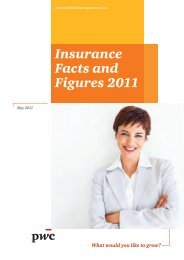Annual Review 2006 - PwC
Annual Review 2006 - PwC
Annual Review 2006 - PwC
You also want an ePaper? Increase the reach of your titles
YUMPU automatically turns print PDFs into web optimized ePapers that Google loves.
Why?<br />
Thought<br />
Leadership.<br />
Resources<br />
The resource sector experienced another spectacular year<br />
with revenue increasing 25 per cent to $222 billion.<br />
In the midst of such strong returns, many stakeholders began to<br />
question how sustainable the growth would prove when confronted<br />
with burgeoning demand and increasing environmental concerns.<br />
<strong>PwC</strong> once again got to the heart of boardroom thinking with<br />
comprehensive annual global surveys examining the state of the<br />
world’s top utilities and mining companies.<br />
In June <strong>2006</strong>, mine* – let the good times roll, a review of global<br />
mining trends, analysed 40 leading companies representing more<br />
than 80 per cent of the industry by market capitalisation. The report<br />
paid special attention to the impact of the ‘awakening giants’ of<br />
Russia, China and India and the future of what have been recordbreaking<br />
years for commodities.<br />
The fi ndings indicate the industry’s performance has exceeded<br />
that of the overall market by 300 per cent over the past two years.<br />
While profi tability is at a high, operating costs have also increased<br />
and may create challenges if commodity prices fall. CEOs appear<br />
focused on maintaining supply and maximising production, while<br />
navigating issues of safety and political uncertainty in many<br />
resource-rich regions.<br />
Financial<br />
Services<br />
The Big Leap surveyed the changes that are being made or need<br />
to be made in technology, investment, mergers and acquisitions,<br />
effi ciency, cleaner fuels and customer relationships in the utilities<br />
industry. The responses from senior executives in Europe, North<br />
and South America, the Asia Pacifi c, Africa and the Middle East<br />
were largely consistent.<br />
The power and gas sector is facing ‘revolutionary’ changes<br />
unprecedented in recent times; the pace of change needs to be<br />
increased with more focus on long-term solutions; and political<br />
and regulatory policy continues to be both the leading catalyst<br />
and hurdle to change.<br />
Additionally, the National Generators Forum and Energy Retailers<br />
Association of Australia commissioned <strong>PwC</strong> to undertake an<br />
independent survey considering the level of liquidity in the<br />
electricity fi nancial contract markets in the context of the National<br />
Electricity Market. The independent analysis found the majority<br />
of respondents perceived the current levels of liquidity in the<br />
Australian market to be adequate for managing risk.<br />
The fi rm expressed its concern about the heavy toll that<br />
over-regulation is taking on fi nancial institutions.<br />
In a July <strong>2006</strong> opinion piece in the Australian Financial <strong>Review</strong>,<br />
Banking & Capital Markets Leader Michael Codling noted that too<br />
much unnecessary regulation had come out as the number one risk<br />
facing our banks for the second year running, according to a survey<br />
of industry participants sponsored by <strong>PwC</strong>. While individual banks<br />
don’t collapse as a result of regulatory overkill, it can damage the<br />
banking system as a whole, and the industry is now rightly throwing<br />
down a challenge to regulators as to whether they have the right<br />
balance of cost and benefi t.<br />
In an Asset magazine article, Why planners need to know about<br />
product rationalisation, partner Peter van Dongen argued the<br />
current legislation in Australia either inhibits investment product<br />
rationalisation or, where it can be practically achieved, makes it<br />
expensive, cumbersome and high risk. Industry data shows that<br />
Australia has a similar number of funds to the US, but only 6 per<br />
cent of the assets under management. With all other fee<br />
assumptions being equal, Australian investment managers have to<br />
price approximately 15 more unit prices per dollar of revenue than<br />
their US counterparts. This heightens risk and increases the need<br />
for legislative change to facilitate sensible product rationalisation.<br />
The <strong>PwC</strong> Investment Management Survey was conducted during<br />
May and June, involving 30 investment management organisations<br />
representing more than $700 billion in assets. The survey found<br />
CEOs generally optimistic about the business environment, though<br />
conscious that many risks still exist. <strong>PwC</strong>’s analysis indicated<br />
organisations need to better align internal processes with service<br />
providers, ensure emerging risks are understood by advisors and<br />
end users, establish more creative staff retention strategies and<br />
evolve customer focus beyond fundamental customer satisfaction.<br />
In November <strong>2006</strong>, we released an analysis of the annual results of<br />
Australia’s four major banks. The fi ndings showed resilient<br />
earnings, up 13.7 per cent on the previous year, primarily due to<br />
volume growth. Cost-to-income ratios improved despite the banks<br />
boosting the number of front-line staff and branches in a bid to<br />
improve the customer experience. As the banks move into an<br />
environment of softening demand for credit and fi erce competition,<br />
investment decisions will remain key.<br />
<strong>Annual</strong> <strong>Review</strong> <strong>2006</strong> 77

















